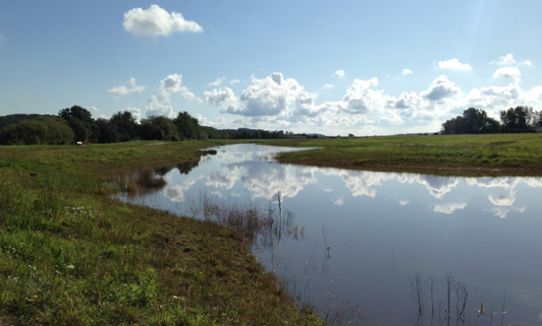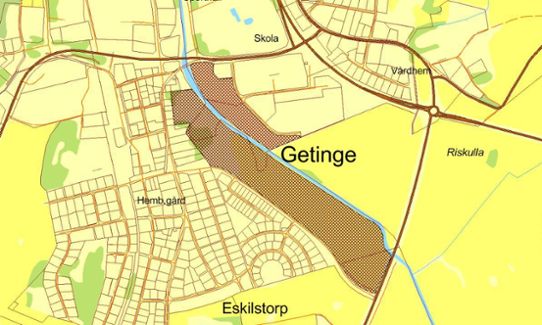The lack of lakes and wetlands in Halmstad Municipality’s flat agricultural landscape creates a limitation in the ability to store and delay water run-off. The landscape’s inability to handle large amounts of water has led to the repeated flooding of the Suseån River that runs through Getinge. The last time was in late summer 2014 when several societal institutions were forced to close down as both streets and properties were flooded.
Measures
To protect the community, the municipality built flood banks along both sides of Suseån River in 2017. The flood banks are dimensioned to be able to handle the current climate’s flows with a recurrence of 100 years. The sediment that the banks were made of comes from excavations along the river and from nearby development areas.
In the area along the river that was excavated, the municipality installed a wetland that can flood instead of homes and roads. The wetland that is framed by the flood banks shall be used as a tool to lower the high levels of nutrients that reached the river through leakage from the surrounding agriculture.

The wetland is also intended to work as a recreation area for the residents of Getinge. The municipality therefore also built walking and exercise trails in the area. Along the walkways, park benches were placed out and an outdoor gym, a fort for preschool children and a dock with outdoor educational equipment were built in the area.

Benefits of the project
The project in Getinge builds on three objectives: protection of the community, nature conservation and recreation. Wetlands are natural habitats for many species and contribute to greater biodiversity. The municipality also wanted to create conditions for an active bird life and therefore made parts of the wetland area difficult to reach and undisturbed.
In line with the EU Water Framework Directive on a good ecological and chemical status in surface and ground water, the idea is that the installed wetland should reduce the concentration of nutrients in the river. The leakage from agriculture will become nutrients for the vegetation in the wetland area, which will lower the nutrient concentration in the river.
Halmstad Municipality mentions in a report on securing and developing the natural capital that Getinge is one of three communities in the municipality that have markedly worse access to recreation areas. The ambition is to attract all generations and create conditions to enjoy readily accessible nature.
Financing
The total cost of the project that has been paid by Halmstad Municipality amounted to SEK 21 million. Nearly SEK 4 million of the SEK 21 million is comprised of grants. Prior to the project with the flood banks in Getinge, cost and benefit analyses were done based on flood scenarios with recurrence times of 10, 50, 100 and 200 years. It came forth that a 10-year flow needs to occur six times for the anticipated damage costs to reach the project’s total cost.
More examples of climate adaptation
This is one of many examples of climate adaptation. There are more in the collection of ideas being built up by the Swedish National Knowledge Centre for Climate Change Adaptation at the Swedish Meteorological and Hydrological Institute (SMHI). The collection of examples has the aim of sharing experiences and providing ideas to everyone who works with climate adaptation. Examples describe concrete measures and challenges in several subject areas. They show how different actors have worked to adapt their activities to the climate changes that are already being noticed today and those that we cannot prevent in the future.